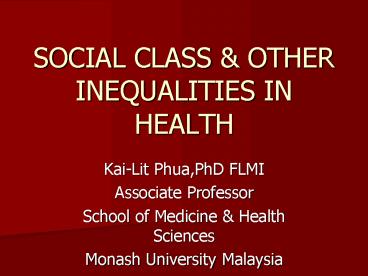SOCIAL CLASS - PowerPoint PPT Presentation
Title:
SOCIAL CLASS
Description:
SOCIAL CLASS & OTHER INEQUALITIES IN HEALTH Kai-Lit Phua,PhD FLMI Associate Professor School of Medicine & Health Sciences Monash University Malaysia – PowerPoint PPT presentation
Number of Views:107
Avg rating:3.0/5.0
Title: SOCIAL CLASS
1
SOCIAL CLASS OTHER INEQUALITIES IN HEALTH
- Kai-Lit Phua,PhD FLMI
- Associate Professor
- School of Medicine Health Sciences
- Monash University Malaysia
2
Biographical Details
Kai-Lit Phua received his BA (cum laude) in
Public Health Population Studies from the
University of Rochester and his PhD in Sociology
(Medical Sociology)from Johns Hopkins University.
He also holds professional qualifications from
the insurance industry.
Prior to joining academia, he worked as a
research statistician for the Maryland Department
of Health and Mental Hygiene and for the Managed
Care Department of a leading insurance company in
Singapore.
He was awarded an Asian Public Intellectual
Senior Fellowship by the Nippon Foundation in
2003.
3
EPIDEMIOLOGY
- Study of the determinants (causes) and
distribution of disease in human populations.
Epidemiologists look for possible relationships
between disease and these factors - Social Class (Class)
- Ethnicity (Race)
- Gender (Sex)
- Age
- Region e.g. urban, suburban, rural
- e.g. low income country, middle
income - country, high income country
- Other e.g. education, illegal worker status
4
UNEQUAL DISTRIBUTION OF DISEASE
- Ethnicity In Malaysia, Orang Asli have the worst
health e.g. malnutrition is more common, they
experience more disability and higher rates of
disease, and they die younger - Gender Males are at higher risk of dying from
certain health conditions. Females are at higher
risk for other health conditions. - Age Young children and old people
- Region Rural people generally have poorer health
than urban people. In the cities, slum dwellers
have poorer health than non-slum dwellers.
5
DISTRIBUTION OF DISEASES ARE AFFECTED BY
SOCIOECONOMIC FACTORS
- Other socioeconomic factors
- Education Better educated people tend to have
better health - Illegal workers They are at higher risk of
developing occupational-related diseases
6
UNEQUAL ACCESS TO HEALTH SERVICES
- Julian Tudor Harts Inverse Care Law
- People who need health services the most are the
least likely to get them - Why? Because of barriers to access
- Financial barriers e.g. unable to pay, cannot
afford to take time off from work to see the
doctor - Geographic barriers e.g. too far to travel
- Cultural barriers
7
SOCIAL CLASS IS A VERY IMPORTANT FACTOR RELATED
TO HEALTH
- A persons social class position is strongly
linked to his or her health status. - Social Class is measured either by a persons
- INCOME or OCCUPATION
- Social Class Groupings
- Upper Class, Middle Class, Working Class,
- Underclass
8
THE SOCIAL CLASS GRADIENT IN HEALTH
- People from lower social classes usually
experience higher disability rates, higher
morbidity rates, higher mortality rates and have
lower life expectancy (than people from the upper
classes) - Thus,
- The lower the social class, the lower the health
status of people
9
THE SOCIAL CLASS GRADIENT IN HEALTH
- It is NOT a statistical artifact
- No matter how social class is measured, the
relationship between low social class and low
health status is found in every country where
health statistics are collected
10
REASONS FOR THE SOCIAL CLASS GRADIENT IN CLASS
- Poverty e.g. not enough money to buy proper food,
being forced to live in poor quality housing in
unhealthy or high crime areas - 2) Lower class people are less well-educated and
- have less knowledge of healthy lifestyles
- 3) Class differences in health-related behaviour
- 4) More dangerous jobs of lower class people
- 5) More stressful lives of lower class people
11
SOCIAL CLASS AND HEALTH
- A low social class position can have a negative
effect on health - But, poor health can also lead to a fall in
social class position (the Downward Drift
hypothesis) e.g. people who become alcoholics or
drug addicts, people who cannot work because of
bad health etc can fall into poverty
12
CAN EQUAL ACCESS TO MEDICAL SERVICES ELIMINATE
THE SOCIAL CLASS GRADIENT?
- In 1947-48, the British Government established
the NHS (National Health Service) and made access
to medical services equal for all social classes. - However, the social class gradient continues to
persist in Britain (documented by the Black
Report) - Thus, we conclude that good health depends on
more than just access to medical services
13
THE END
- THANK YOU

